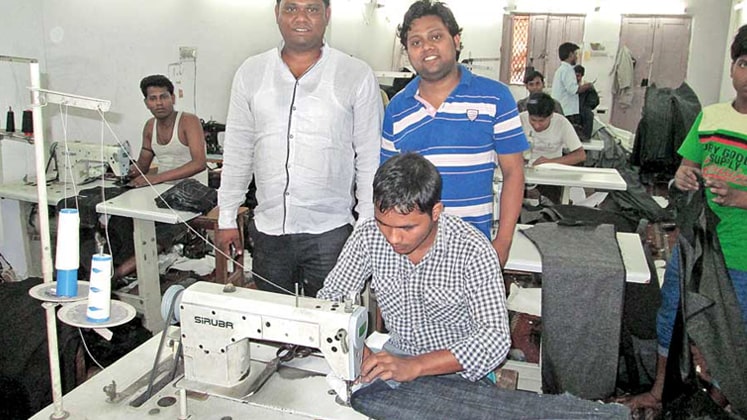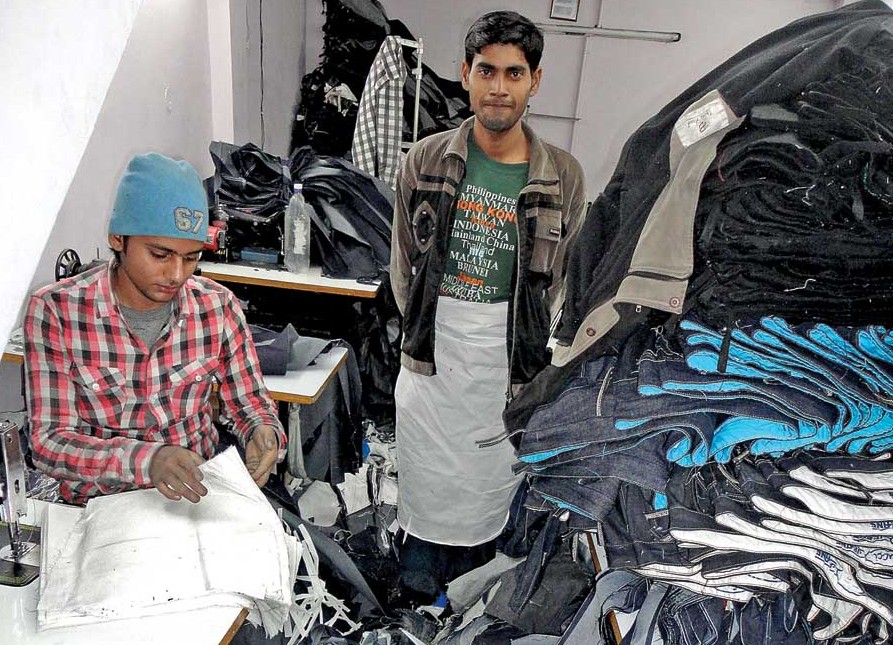
Denim jeans as a product category only brings regret for the Indian export market as India has never been able to make a mark at the global level despite the huge base of fabric manufacturers like Arvind, Aarvee, KG Denim, Sangam and Raymond. It is these same companies who are also supplying to countries like Bangladesh, to which India has lost most of its denim bottoms business. Yet, to say that manufacturing of jeans is not happening in the country would be misleading, and with a population of more than a billion, the demand for denim bottoms has been increasing stupendously in the domestic market, and surprisingly this huge requirement is being fulfilled by the largely unorganized brand-driven manufacturing setups in small hamlets around the country like Gandhi Nagar in Delhi and Bellary near Bangalore. After a series of visits to Gandhi Nagar and Tank Road locality of New Delhi, followed by a survey, Team StitchWorld puts the spotlight on the manufacturing setups and costing structure of the cheapest denim bottom manufacturing hub of the country.
“The new facility we plan to setup will not only upgrade our manufacturing capabilities, but will also enable us to cater to the brands like Walmart, who plan to enter India.” – Pawan Bhansali, FCB Garment Tex India
Who can believe that India actually produces more denim jeans than Bangladesh, but unlike Bangladesh, the manufacturing is happening in unorganized setups in and around Delhi, in areas including Tank Road, Gandhi Nagar, Seelampur, Welcome Colony (including Jaffrabad) and Maujpur. Down south, a similar cluster is in Bellary, Karnataka.
Being the biggest among all the centres, Gandhi Nagar alone houses more than 5,000 manufacturing units with 10 or more machines, averaging around 20 machines per unit and consuming around 5 million metres of denim fabric per month. More than 3,000 wholesalers and around 500 small and big brands work day and night to feed the nation with fashionable jeans, but only few have their own units.
“Being one of the biggest fabricator of the region, commitment to a single brand has made us what we are today, as we believe in giving a total turnkey solution to a brand.” – Nizam, Nizam Enterprises
The size of the market makes available jeans at wide range of costing and quality, branding the market as cheap denim bottoms sourcing destination. Another reason why Gandhi Nagar and its nearby regions are touted as cheap denim bottom sourcing hub is also because of the under-developed infrastructure. For those looking to source from the area, the most striking thing one should keep in mind is that the more one goes into the interiors the cheaper he can get them made.
Manufacturing Setups
Denim jeans are manufactured in a single piece rate system, where a single sewing operator manufactures a complete denim bottom on a lockstitch black (umbrella) sewing machine, and the special operations like inseam, outseam, waistband, button holing and attaching are done by different operators on specialized automated machines like feed-off-the-arm, double needle chainstitch machine, overlock, bartack, button holing and snap button attaching machines.

While the bigger brands have in-house operations with or without washing facilities, smaller retailers/brands are outsourcing the services of this manufacturing hub which is working on a shared tailoring system with many sub cycles available for manufacturing as per convenience of the retailers/brands placing the order. The manufacturing options available are:
- Dedicated fabricators making jeans for a single brand with all operations in-house except washing. In such cases, brands station a person as the factory manager for getting out the production.
- Fabricators doing lockstitch operations + automated operations (inseam, outseam, waistband attachment) + bartacking + button holing and sewing.
- Fabricators doing only lockstitch operations and automated operations.
- Fabricators doing only lockstitch operations in-house.
- Then there are job-workers, each doing individual operations of either inseam, outseam, waistband attachment, i.e. the automated operations, bartacking, button holing & sewing, finishing and packaging. These job workers mainly work for fabricators with fewer operational capabilities.
- The 1st category are hardly 5% of the total manufacturers or job workers, while the 2nd & 3rd are the most dominant category of manufacturers (65%). The 4th and 5th category would be around 15% of the unorganized manufacturers in Gandhi Nagar and Tank Road. A more in-depth and detailed description of the manufacturing setups has been given in Table 1 and it should be noted that the people doing individual or a set of operations might prove more cost-effective than the units doing a complete jean with all the essential operations in-house, but then they are the ones with a definite quality and delivery promise.
While the bigger brands have in-house operations with or without washing facilities, smaller retailers/brands are outsourcing the services of this manufacturing hub, which is working on a shared tailoring system as per convenience of the retailers/brands.
Almost 90% of the fabricators and manufacturers in Gandhi Nagar and Tank Road work on black (umbrella) sewing machines, attached with clutch motors, which cost around Rs. 6,000, the reason given by most for not using sewing machines from companies like Juki and Brother for basic lockstitch operations, is that the sewing operators are not well acquainted with the same, and both the speed and quality of the operations suffer.
Besides the cost and low skill levels which favour local machines, another reason for not using Juki machines or ‘white machines’ as they are commonly referred to is the shortage of sewing operators. However, white machines are normally used for sewing shirts. The available operators can choose the types of machines to work on… unbelievable in a country famous for exporting shirts.
 For critical operations, automated machines like feed-off-the-arm, double needle chainstitch, overlock and bartack used by the manufacturers are mostly second-hand machines, costing around Rs. 50,000 to 60,000 – like very old version of automates from Kansai, PFAFF, Siruba and Juki, mostly sourced from Dubai. Moreover there is absence of any kinds of attachments or work aids for doing various critical operations, and apart from operations mentioned no other automated workstations are used like for pocket setting, J-stitch, belt loop attaching, etc. The advanced setups of Gandhi Nagar have near about 60-70% white machines from Juki (majorly) and Siruba. Besides overlock, feed-off-the-arm, waistband attaching and bartacking; few smaller units make only belt loop on the specialized machines. One of the most striking observations is the absence of any kind of quality checks or in-line checkers. The operator himself is responsible to check quality.
For critical operations, automated machines like feed-off-the-arm, double needle chainstitch, overlock and bartack used by the manufacturers are mostly second-hand machines, costing around Rs. 50,000 to 60,000 – like very old version of automates from Kansai, PFAFF, Siruba and Juki, mostly sourced from Dubai. Moreover there is absence of any kinds of attachments or work aids for doing various critical operations, and apart from operations mentioned no other automated workstations are used like for pocket setting, J-stitch, belt loop attaching, etc. The advanced setups of Gandhi Nagar have near about 60-70% white machines from Juki (majorly) and Siruba. Besides overlock, feed-off-the-arm, waistband attaching and bartacking; few smaller units make only belt loop on the specialized machines. One of the most striking observations is the absence of any kind of quality checks or in-line checkers. The operator himself is responsible to check quality.
The cutting rooms use straight knife cutting machines as the units are unaware of even about the basic cutting machines, what to talk about automated cutters and spreaders. The cutting operators are paid as per the number of jeans that can be sewn from the fabric cut by them and they are paid around Rs. 2 to 3.5 per denim jeans.
Washing units are the only facility which is not available in the Gandhi Nagar region and for which denim jeans are sent to Mayapuri and Tronica City for the same, and few plants are also available in Ghaziabad and Faridabad, charging between Rs. 40 to 80 per jeans, depending on the washing quality.

Manufacturing Operations
The sewing units are categorized as per the type of specialized machines – overlock, feed-off-the-arm, double-needle chainstitch waistband attaching, bartack, button attaching and button holing machines, all are housed either as individual units or a grouping of machines as a unit.
The operators working on these 4-5 specialized machines are not treated as kaarigars. The kaarigars (doing lockstitch operations) are all the operators who work on basic umbrella machines with motors.
Sewing Process Flow
1. First the front is prepared by all – pockets and zipper.
2. Yoke is attached to the back and then the pockets are attached – Basically the back is prepared.
3. On the feed-off-the-arm machine, the front and back are attached via inseam.
4. The panels are passed on to the overlock machine for attaching the outseam.
5. Top stitch is done on the outseam.
6. Loops are attached on the front but not closed.
7. The waistband is attached to the jeans and the belt loops are closed.
8. Another operator cuts the waistband.
9. Bartack is done on all the required places, wherever required and all together.
10. Lastly the hemming of the denim bottom is done.
*The operations 6 & 7 mentioned here can be done in any order…

The usual size of the lot given to a sewing operator for completion is of 100 jeans and a good operator (only doing operations done on lockstitch machines) can do 20-25 jeans per day, in 12 to 14 hours and gets paid anything between Rs. 22 to 40 per jean depending mostly upon the time taken for the back pocket design, with rates which can go up to Rs. 20 per pocket. A weekly average comes around to 150 jeans, from a good operator. They start with one operation as per their convenience and do the same for the whole lot for the complete day and repeat the same throughout. The process doesn’t matter as the responsibility of sewing the entire lot is on the sewing operator. For example, if an operator is doing back pocket attachment today, he will continue to do so for the entire lot before taking up next operation.
Apart from the fabric one would just have to provide the inner lining fabric, labels, price tags, leather patch for back, buttons and rivet, and if they are not able to provide all these things they will do the needful and charge Rs. 16 per jean more, which can go up to Rs. 30 depending on the quality of the merchandise, inclusive of the packing material. Pure leather patches although rarely used by the manufacturers, cost from Rs. 7 to 8. The sewing thread is provided by the manufacturer only, without any additional cost.
Almost 90% of the fabricators and manufacturers in Gandhi Nagar and Tank Road work on black (umbrella) sewing machines, attached with clutch motors, which cost around Rs. 6,000. As the sewing operators are not well acquainted with sewing machines from Juki and Brother, both the speed and quality of the operations suffer.
The fabricators with most of the operations and machines in-house charge from Rs. 60 to 110 per jean and give complete finished and packed product excluding the cost of fabric and washing. A sewing operator (kaarigar or the one who does the lockstitch operations) is paid anywhere from Rs. 16 to 40 per jean and for other operations the worker is paid as per the operations they do. The range of Rs. 16 to 40 is wide because it includes jeans for kids also which generally range from Rs. 16 to 25, a lot cheaper than what is being charged for a regular denim jeans, as the productivity in kidswear is quite high due to shorter seams. Also automated operations can be at times substituted with lockstitch machines, due to which the operators end up making the same amount of money as compared to workers sewing regular jeans. Manufacturers believe that by setting up your own factory one can save at the maximum Rs. 2-3 per jeans, which for many is not worth the effort.






